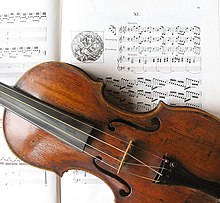Scordature
The scordatura or scordatura ( it . : scordare = to change tune ) is a tuning of a stringed instrument that deviates from the norm. Scordatures are often used on the violin and guitar. The opposite, i.e. the usual tuning, is the chordatura or accordatura (it .: accordare = to vote ). Scordatures are mostly motivated by playing technique, but occasionally also have extra-musical significance (A. Berg).
violin
The Scordatura allowed already in deep layers of playing difficult chords and opened the instrument at the same time other sound options due to overvoltage or undervoltage of the strings . However, a string cannot be immediately tuned two tones lower without immediately detuning the chordature. This and the development of new finger techniques will probably have been the reasons for the abandonment of the technique, which was mainly used in the period between 1600 and 1720. During this time, much of the literature for the viola d'amore was published in scorched form.
The first to use the scordature on the violin appears to have been Biagio Marini . In his Sonata d'Inventione, Op. 8 (Venice 1629), the violinist has to tune the E string down by a third to a C during the piece. Georg Philipp Telemann used the scordatura in some works and in exceptional cases Niccolò Paganini and Gustav Mahler , also Igor Stravinsky ( The Firebird ) . When playing corresponding pieces, one often has a second or more tuned instruments ready. In order to make reading easier, notation is made in fingering or a kind of tablature that does not correspond to the sounding note. The violinist picks up the notes in the same way as with a normally tuned violin, but the scordatura makes other notes sound.
The best-known musical example from Baroque music are the Rosary or Mystery Sonatas by Heinrich Ignaz Franz Biber , in which 15 different tunings are used (see figure above, the violin is in normal tuning for the 1st and 16th sonatas).
Wolfgang Amadeus Mozart notates the solo viola part of his Sinfonia concertante for violin and viola in E flat major, K. 364, half a tone lower, i.e. in D major, which is much easier to play. The viola is tuned a semitone higher, which also gives it greater tonal brilliance.
The scordature also appears in the folklore tradition; Scottish and Norwegian ( Hardanger ) fiddlers change the tuning of the two lower strings and thus have suitable drones available.
Web links
guitar
The scordature is also used on the guitar. Typical moods in addition to the standard tuning are " open tunings " ( Open Tuning ) so that chords simply, Barrégriffe can be achieved. Open moods are preferred when playing bottleneck , but also without bottleneck - for example by Keith Richards .
As early as the Renaissance, guitarists retuned their strings in exceptional cases. In France, the chords resulting from such a scordature, if not just one string was retuned , were called nouvelles accordes . For example in the volume with court dances published by Robert de Visée in 1682.
The dropped-D tuning is popular with metal guitarists .
In addition, other moods to improve playability or for use in certain musical styles are possible.
Lute
Also already in the renaissance of the voices are loud deviations from the usual quart quart major third quart quart - According mood (4-4-3-4-4) occupied. For example, Sebastian Virdung described such a "trigger" in his Musica getutscht , in which the lowest pair of strings was tuned down by one second (5-4-3-4-4). A retuning to "Leyrer (train)" was occasionally used with a kind of open tuning the bagpipe - or Drehleier like drones to imitate when plectrum on the sounds. In Hans Neusidler's lute compositions, what he calls the “Judentanz” moods are worth mentioning.
literature
- Dagmar Glüxam: Scordatura . In: Oesterreichisches Musiklexikon . Online edition, Vienna 2002 ff., ISBN 3-7001-3077-5 ; Print edition: Volume 5, Verlag der Österreichischen Akademie der Wissenschaften, Vienna 2006, ISBN 3-7001-3067-8 .
- Peter Petersen : »… so relax me!« - Scordatures and their semantics in Alban Berg's music. In: Archives for Musicology 76, 2019, pp. 121–134.
Remarks
- ↑ Peter Petersen : »… so relax me!« - Scordatures and their semantics in Alban Berg's music. In: Archives for Musicology 76, 2019, pp. 121–134.
- ↑ Johannes and Ingrid Hacker-Klier: The guitar. An instrument and its history. edited and introduced by Santiago Navascués, Bad Buchau 1980, ISBN 3-922745-01-6 , pp. 115, 122. (Biblioteca de la Guitarra)
- ^ Rainer Franzmann: Symmetrical tuning for guitar. Tuning and strings of the modern guitar. In: Guitar & Laute 4, 1982, 3, pp. 155–159.
- ↑ Peter Päffgen: Abzug and Leyrer Zug: Two lute tunings of the 16th century. In: Guitar & Laute 2, 1980, 6, pp. 36-42.

